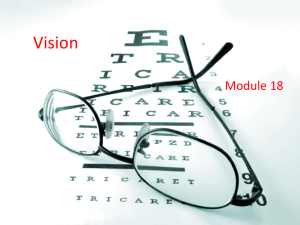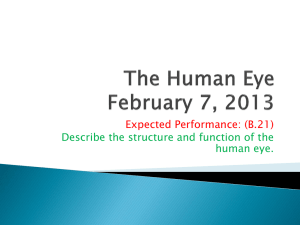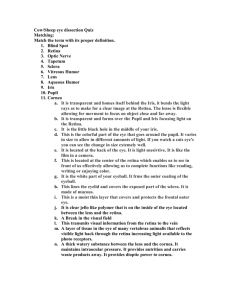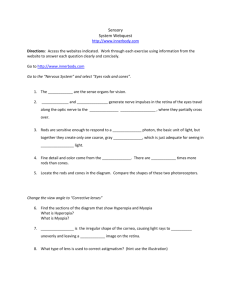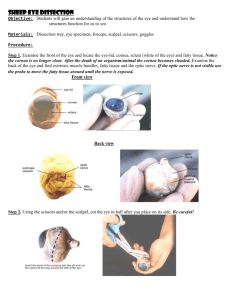THE EYE - El Camino College
advertisement
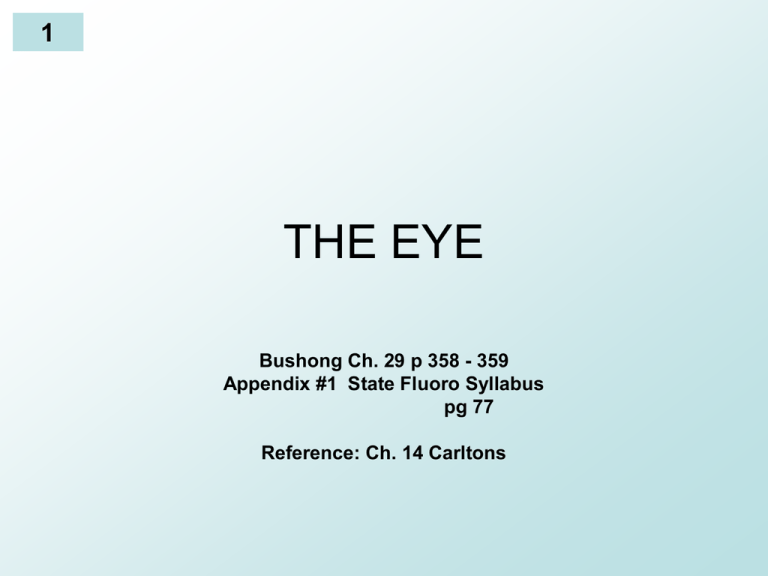
1 THE EYE Bushong Ch. 29 p 358 - 359 Appendix #1 State Fluoro Syllabus pg 77 Reference: Ch. 14 Carltons 2 Early Fluoroscopy 3 4 5 The eyes are the window to the soul………. 6 Red goggles for dark adaptation •Fluoroscopy was performed •in total darkness •so the eyes had to be adjusted •for 20 - 30 minutes by wearing red goggles 7 8 • FOVEA CENTRALIS • CENTRAL PART OF RETINA • CONES TIGHTLY PACKED • REMAINDER – CONES DIMISH = MORE RODS 9 Human Vision • Light passes through the lens, where light is focused onto the retina. • Between the cornea and the lens is the iris, which acts like a camera diaphragm = controls the amount of light admitted into the eye 10 the retina • The retina is important because it contains the rods and cones. • The sharpest point of vision is located in the center in an area called the fovea centralis. 11 RETINA • contains millions of specialized photoreceptor cells called rods and cones • That convert light rays into electrical signals that transmitted to the brain through the optic nerve. • Rods see in dim light and • Cones provide the ability to see in color 12 Visual Physiology 2 types of light receptors RODS • • • • NIGHT VISION SCOTOPIC PERCEIVE GRAYS PERIPHERY OF RETINA = DIM OBJECTS SEEN BETTER – 1000 X MORE SENSITIVE • 30 min dark adaptation CONES • • • • • DAYLIGHT PHOTOPIC PERCIEVE COLOR CENTER OF RETINA BETTER VISUAL ACUITY New II much brighter 13 The rods • These are located at the periphery of the retina • There are fewer of them and they are sensitive to low levels of light. • Night vision (scotopic vision) uses the rods of the eye to see • The rods are colorblind 14 The cones • Cones are located at the center of the retina in the fovea centralis • They respond to intense light levels. As such, these are used for our daylight (phototropic vision). • Cones have better visual acuity and better contrast perception. • Cones perceive color 15 Eat the ice cream CONE in the DAYLIGHT! 16 17 Macula & Fovea centralis • The macula, located in the center of the retina, is where most of the cone cells are located. • The fovea, a small depression in the center of the macula, has the highest concentration of cone cells. • The macula is responsible for central vision, seeing color, and distinguishing fine detail. • The outer portion (peripheral retina) is the primary location of rod cells and allows for night vision and seeing movement and objects to the side (i.e., peripheral vision). 18 CORNEA • The cornea is a thin transparent protective covering that protects the eye. • It has no blood vessels and it helps focus light onto the retina • Light rays bounce off all objects. If a person is looking at a particular object, such as a tree, light is reflected off the tree to the person's eye and enters the eye through the cornea 19 IRIS • located between the cornea and the lens • colored part of the eye • It controls the amount of light that is admitted to the eye by dilating or constricting the pupil. • Bright light causes contraction of the iris allowing only a small amount of light to hit the pupil • In dim light, the pupil enlarges to allow more light to enter the eye. 20 IRIS • The structure which gives the "color" to the eye. • The pupil is the hole in the iris. • Contraction of the iris makes a pupil small. • Relaxing of the iris makes the pupil large. 21 22 LENS & PUPIL • focuses the light that passes through the pupil onto the retina where the light receptors are located • The pupil is the opening to the eye. As the iris opens and closes, it causes the pupil to dilate or contract. • Light has to pass through the pupil to reach the retina 23 VISUAL ACUITY • ABILITY TO PERCEIVE FINE DETAILS • INTEGRATION TIME = 0.2 SEC (how long it takes to identify something) • Photopic acuity is 10 x greater than scotopic • Contrast perception is our ability to detect differences in brightness • Normal viewing distance 12 – 15 inches 24 Binocular vision • is the best we can see at and is 12-15 inches from the object we are looking at. • We have a blind spot at about 9 inches and can’t see from the periphery of the eye. • Remember… integration time: 0.2 sec. and it is the ability to see and recognize everything we will 25 • • • • • VISION EYE SEES 32 SHADES OF GRAY COMPUTER 256 – 8 bit to 1024 12 bit depth SHADES REGARDING CINE: 32 FRAMES SOME FLICKER (OLD MOVIES) 60 FRAMES = NO FLICKER 26 The Eyes & Radiation Dose • What is the allowable annual limit for the eyes? _______________________ • What problems with the eyes were seen with early Radiologists? 27 The Eyes & Radiation Dose • Cataracts (cataractogenic effects) P49 RAD – RHB SYLLABUS • Formation of Cataracts – dose of several 110 rads • Fibers in lens of eye are specialized to transmit light • Damage to these (particularly to the developing immature cells – can result in cataracts) 28 Now your turn.. 29 30 The Early years • Because of the high dose to the patient and to the operator’s eyes, radiation damage was noted shortly after the invention. • Thomas Edison noted that his vision was deteriorating because of the radiation. • The possibilities of this new find outweighed the dangers. 31 •CATARACS •Dangers of early fluoro •DOSE RESPONSE ?? 32 33 34



